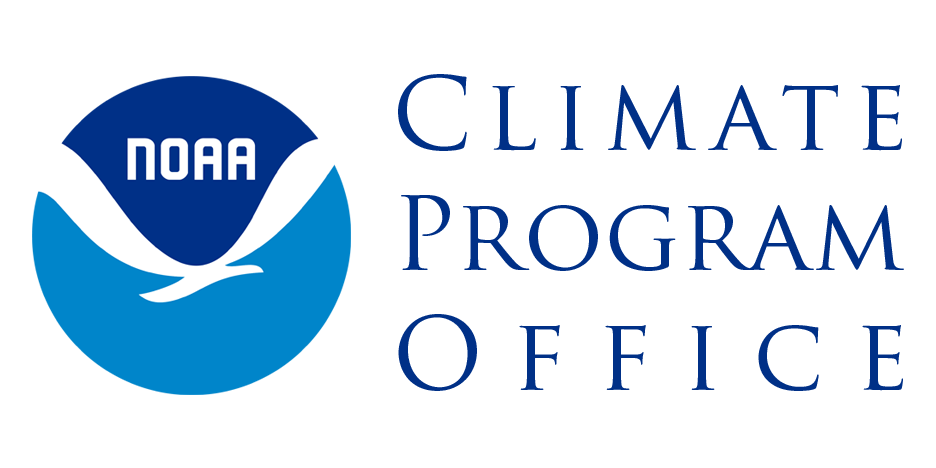**In view of the disruptions associated with hurricane Irma, the deadline for full applications to all FY18 MAPP Program competitions has been postponed to 5:00 p.m. Eastern Time, September 25, 2017. Visit Grants.gov for more information. (Updated September 15 2017)
Funding Opportunity Title: Climate Program Office FY 2018
Announcement Type: Initial
Funding Opportunity Number: NOAA-OAR-CPO-2018-2005133
Catalog of Federal Domestic Assistance (CFDA) Number: 11.431, Climate and Atmospheric Research
Applications received after these dates and times will not be considered for funding.
- Letter of Intent: (LOIs) for all competitions (with the exception of the three MAPP Program competitions) should be received by email by 5:00 p.m. ET on June 14, 2017. Letters of Intent for the three MAPP Program competitions should be received electronically by 5:00 p.m. ET on June 28, 2017.
- Full Applications: Full applications for all competitions (with the exception of the three MAPP Program competitions) must be received by 5:00 p.m. Eastern Time, August 14, 2017. Full applications for the three MAPP Program competitions must be received by 5:00 p.m. ET on September 25, 2017.
Applications must be submitted via www.grants.gov. For applications submitted through grants.gov, the basis for determining timeliness is the receipt notice issued by www.grants.gov, which includes the date and time received. Emailed or faxed copies of applications will not be accepted.
CPO supports competitive research through three major program areas: Ocean Observing and Monitoring (OOM); Earth System Science and Modeling (ESSM); and Climate and Societal Interactions (CSI). Through this Announcement, CPO’s activities are seeking applications for seven individual competitions in FY 2018. Prior to submitting applications, investigators are highly encouraged to learn more about CPO and its programs, as well as specific program priorities for FY 2018.
This information, along with the names and contact information of relevant Competition Managers, is provided in information sheets that can be found below.
In FY 2018, approximately $8 million is anticipated to be available for approximately 90 new awards pending budget appropriations. It is anticipated that most awards will be at a funding level between $50,000 and $300,000 per year with exceptions for larger awards, depending on the program. Federal funding for FY 2019 may be used to fund some awards submitted under this Federal Funding Opportunity. Current or previous grantees are eligible to apply for a new award that builds on, but does not replicate, activities covered in existing or previous awards. Current grantees should not apply for supplementary funding through this announcement. Investigators, please review this page for more detailed information and instructions prior to submitting applications.
General Information
CPO manages competitive research programs through which NOAA funds high-priority climate science, assessments, decision support research, outreach, education, and capacity building activities designed to advance the understanding of Earth’s climate system and to foster the application for of this knowledge to enable effective decisions. CPO supports research that is conducted across the United States and internationally. CPO also provides strategic guidance for the agency’s climate science and services programs and supports NOAA’s contributions to the U.S. Global Change Research Program (USGCRP) and its National Climate Assessment and similar international endeavors.
FFO at a Glance
LINKS TO FULL FFO AND GRANTS.GOV LISTING
QUESTIONS/WHO TO CONTACT
Diane Brown, CPO Grants Manager
Email: diane.brown@noaa.gov
Earth System Science and Modeling Division (ESSM)
Competition 1 – AC4: The Role of Reactive Nitrogen in Biogenic VOC Oxidation and Aerosol Formation
Contact: Monika Kopacz
Email: monika.kopacz@noaa.gov
Competition 2 – MAPP: Advancing Earth System Data Assimilation
Contact: Heather Archambault
Email: heather.archambault@noaa.gov
Competition 3 – MAPP: Addressing Key Issues in CMIP6-era Earth System Models
Contact: Daniel Barrie
Email: daniel.barrie@noaa.gov
Competition 4 – MAPP: Climate Test Bed – Advancing NOAA’s Operational Subseasonal to Seasonal Prediction Capability
Contact: Heather Archambault
Email: heather.archambault@noaa.gov
Ocean Observing and Monitoring (OOM)
Competition 5 – High-quality data sets for enhancing predictions and informing stakeholders
Contact: David Legler
Email: david.legler@noaa.gov
Climate and Societal Interactions (CSI)
Competition 6 – Extreme Events Preparedness, Planning and Adaptation Within the Water Sector
Competition 7 – Coping with Drought in Support of the National Integrated Drought Information System (NIDIS)
Contact: Nancy Beller-Simms
Email: Nancy Beller-Simms@noaa.gov
IMPORTANT DATES/DEADLINES
Letters of intent (LOIs) for all competitions (with the exception of the three MAPP Program competitions) should be received by email by 5:00 p.m. ET on June 14, 2017.
Letters of Intent for the three MAPP Program competitions should be received electronically by 5:00 p.m. ET on June 28, 2017.
A response to the LOI from the Competition Manager (e-mail or letter) will be sent to the investigator within four weeks after the LOI’s due date encouraging or discouraging a full application based on its relevance to the targeted Competition.
Full Applications
Full applications for all competitions (with the exception of the three MAPP Program competitions) must be received by 5:00 p.m. Eastern Time, August 14, 2017.
Full applications for the three MAPP Program competitions must be received by 5:00 p.m. ET on September 25, 2017
Applications received after these dates and times will not be considered for funding.
Applications must be submitted via www.grants.gov. For applications submitted through grants.gov, the basis for determining timeliness is the receipt notice issued by www.grants.gov, which includes the date and time received.
For applicants without internet access, please contact the CPO Grants Manager Diane Brown by mail at NOAA Climate Program Office (R/CP1), SSMC3, Room 12734, 1315 East-West Highway, Silver Spring, MD 20910 to obtain an application package. Please allow two weeks after receipt for a response. Hard copy submissions will be date and time stamped when they are received in the Climate Program Office.
Emailed or faxed copies of applications will not be accepted.
COMPETITIONS, INFORMATION SHEETS & CONTACTS
Information Sheet (pdf)
Number: 2633911
Manager: Monika Kopacz |
Aerosols and aerosol formation have a significant influence on both climate and air quality. There are, however, a number of uncertainties in fully understanding and representing reactive nitrogen processes in the atmosphere as they relate to aerosol formation. In FY18, as part of its continuing interest in the nitrogen cycle, the AC4 program announcement focuses on laboratory, modeling, and analysis studies (of existing field data) that investigate the mechanisms of BVOC oxidation involving reactive nitrogen species.
Competition 2: MAPP – Advancing Earth System Data Assimilation
Information Sheet (pdf)
Number: 2647250
Manager: Heather Archambault |
The MAPP Program solicits exploratory projects on coupled data assimilation in support of NOAA’s plans for unified modeling and prediction across scales. Additional foci include improving data assimilation or data assimilation-based monitoring products for individual components of the Earth system (i.e., the cryosphere, ocean, including biogeochemistry, land surface, and atmospheric chemistry).
Competition 3: MAPP – Addressing Key Issues in CMIP6-era Earth System Models
Information Sheet (pdf)
Number: 2647349
Manager: Dan Barrie |
The MAPP program is soliciting projects that address key issues in the Coupled Model Intercomparison Project – Phase 6 (CMIP6) Earth System Models — in particular, systematic biases in these models. Projects will utilize CMIP-6 model data to examine and improve the representation of processes associated to the cryosphere, weather and climate extremes, and sea level and coastal dynamics.
Competition 4: Climate Test Bed – Advancing NOAA’s Operational Subseasonal to Seasonal Prediction Capability
Information Sheet (pdf)
Number: 2647351
Manager: Heather Archambault |
The objective of this competition is to involve the external community in advancing the NOAA/NCEP/NWS Climate Prediction Center’s operational subseasonal to seasonal prediction capabilities as part of the NOAA Climate Test Bed. Priorities include optimizing the North American Multi-Model Ensemble system to meet operational requirements, and testing experimental subseasonal-to-seasonal prediction methodologies (e.g. new calibration or post-processing techniques) developed in the broader community for operational purposes
Competition 5: OOM – High-quality data sets for enhancing predictions and informing stakeholders
Information Sheet (pdf)
Number: 2648028
Manager: David Legler |
The OOM Monitoring Program is soliciting projects that will develop long term, climate quality data sets and products that will address key climate processes and uncertainties, particularly those that can reduce uncertainty in key processes in climate models, and those that inform our understanding, monitoring and projections of the frequency and occurrence of weather and climate extremes.
Competition 6: SARP – Extreme Events Preparedness, Planning, and Adaptation Within the Water Sector
Information Sheet (pdf)
Number: 2648827
Manager: Nancy Beller-Simms |
SARP will award grants focused on developing strategies for increasing community resilience in U.S. towns, municipalities or small cities planning for the impacts of extreme precipitation events (too much or too little water) on their civilian population. Proposals should focus on the impact of extreme events on water resources and water-resource dependent activities (e.g., land use, watershed and water utility planning, emergency preparedness), specifically the connection between communication of risk and the design and implementation of risk mitigation and reduction strategies.
Competition 7: SARP – Coping with Drought in Support of the National Integrated Drought Information System (NIDIS)
Information Sheet (pdf)
Number: 2648829
Manager: Nancy Beller-Simms |
The SARP portion of the Coping with Drought Initiative will focus on advancing NIDIS regional drought early warning systems through a better understanding of how to better provide early warning through enhanced language, metrics and joint decision spaces (e.g., calendars, etc.).
FOR FEDERAL INVESTIGATORS
Letters of Intent for the three MAPP Program competitions should be received electronically by 5:00 p.m. ET on June 28, 2017.
Full applications for all competitions (with the exception of the three MAPP Program competitions) must be received by 5:00 p.m. Eastern Time, August 14, 2017.
Full applications for the three MAPP Program competitions must be received by 5:00 p.m. ET on September 25, 2017
WHERE TO SUBMIT
Visit Grants.gov and
click on Apply for Grants. You may also directly view the Grants.gov listing here.
Federal Funding Opportunity Number:
NOAA-OAR-CPO-2018-2005133
Applicants without Internet access:
Please send mail to:
Diane Brown
CPO Grants Manager
NOAA Climate Program Office (R/CP1), SSMC3, Room 12734
1315 East-West Highway
Silver Spring, MD 20910
Please allow two weeks after receipt for a response.





